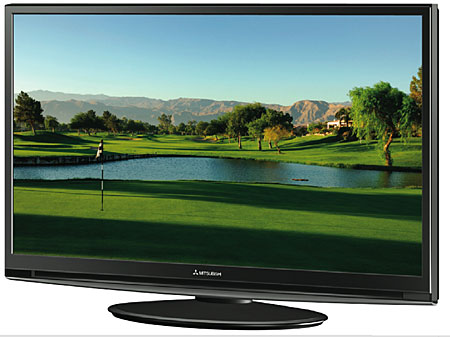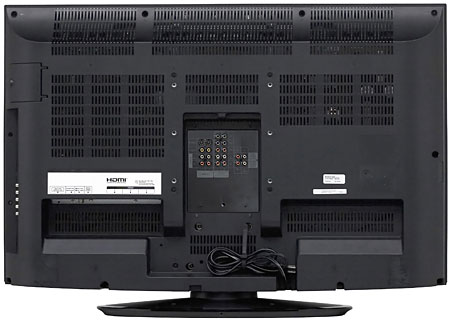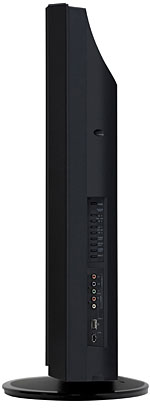Mitsubishi LT-46144 LCD Flat Panel HDTV

Description
The Mitsubishi has a swivel base that allows for a 30-degree offset to either side. Its flat black frame is thinner than most on the top and sides, but wider at the bottom to accommodate the thin slot where the sound exits.
The sound is one of the set's weaker links, with a very obvious, canned coloration that makes people sound like they have serious head colds. Plan on an external sound system for any serious listening.
A major feature here is 120Hz operation. Mitsubishi calls this "Smooth120Hz," and it's available only on the company's 144- and 244-series sets. It doubles video's standard 60Hz frame rate to 120Hz, which is claimed to produce less motion blur (a particular weakness of LCD flat panel displays). The added frame is not simply repeated, but interpolated using a Mitsubishi-developed algorithm.
The set will also accept and display a 1080p/24 source, such ad Blu-ray or HD DVD. However, rather than the optimum technique of upconverting 1080p/24 to 1080p/120 directly, to match the native 120Hz frame rate of the set, 1080p/24 inputs are first converted to 1080p/60 by adding 3/2 pulldown. The set then handles the signal as it would any 1080p/60 input by frame-doubling it to1080p/120.

The set has three HDMI 1.3 inputs. While Mitsubishi states that these inputs are therefore "compatible with" the Deep Color and x.v.Color features of HDMI 1.3. There is no commercially available program material with those features at present, apart from the outputs of a few camcorders.
The LT-46144 also supports Mitsubishi's NetCommand, which "seamlessly integrates selected older A/V products with new and future digital products." The set also supports NetCommand for HDMI, which expands this function to operate through the HDMI link for devices that are interconnected via HDMI. I did not test either the vanilla or HDMI versions of NetCommand for this review.
There are also two antenna inputs, coaxial digital and L/R analog audio outputs to feed sound from the set's onboard ATSC and NTSC digital tuners to your outboard sound system, and an IR emitter for use with the NetCommand feature.
There is no CableCARD slot here, nor any PIP or POP. This is the third set I've reviewed recently that lacks both of these features. I smell a trend.
 A side panel contains an additional component input with L/R audio, plus a USB port that can be used to view digital pictures.
A side panel contains an additional component input with L/R audio, plus a USB port that can be used to view digital pictures.
The HDMI inputs are buried deep within a recess on the back panel. This would only be a minor inconvenience if not for the fact that there's a bump in the rear panel so close to one of the HDMI inputs that the cable exiting from it must be bent immediately below the plug. Many HDMI cables do not like to be bent sharply.
You cannot select inputs directly but rather must choose them from a menu. Mitsubishi's Easy Connect auto input sensing feature, however, makes this less painless than usual by prompting you to assign a name to a source when you connect it (from a pre-set list). It then ignores unused inputs on the input selection menu.
There's the usual assortment of video controls: Contrast, Brightness, Color, Tint, and Sharpness. There's also a Backlight control and a two-position color temperature adjustment—High and Low. No other color temperature adjustments are provided in the user menus, and a code-protected service menu provides only overall adjustments for red, green, and blue (for both the High and Low color temp options), not the more desirable, separate controls for the low and high end of the brightness range.
The lack of other exotic video controls typical of much of Mitsubishi's competition is not necessarily a negative. Those offbeat controls can give newbies the opportunity to mess up the picture, while leaving more experienced users—and reviewers—scratching their heads trying to find some odd combination of settings that can improve the picture.
There are four Picture Modes: Brilliant, Game, Bright, and Natural. (Game is available only when you name an input either Game or PC.) Only some of these can be adjusted separately for each input. I obtained roughly equivalent performance at first from Bright and Natural, given appropriate adjustments to the user controls, but Natural eventually pulled ahead. Natural, when well calibrated and adjusted, performed as well or better than any other mode.
The partially backlit Mitsubishi remote is fine, with conveniently positioned, well-sized buttons. It can control four other products in normal operation when programmed with the right codes, and more if you can use it in conjunction with Mitsubishi's NetCommand feature.
Performance
Many new LCDs are producing black levels that are exceptional compared to LCD's recent past. They're not yet the equal of the best plasmas or microdisplays, but nevertheless very impressive for a technology that was limited to medium grays as blacks not so long ago.
For a movie fan, if a set can't reproduce believable blacks then nothing else it does matters. And the Mitsubishi is right up there with the best LCD flat panels I've seen in this regard. Not the best I've seen and measured from all flat panel technologies, but fully satisfying on 95% of the program material I watched.
Out of the box, the Low color temperature was too cool, ranging in its Low setting from just over 6900K to about 7200K rather than the 6500K (or, more precisely, D6500) standard. Many competitors can't even get that close, or choose not to.
A calibration did improve this by a worthwhile margin. While I did occasionally sense a hint of excess green, it was elusive. Both flesh tones and green foliage (two of the most difficult colors to reproduce believably since we all see them every day—unless you live in the Sahara desert) were very convincing.
Mitsubishi's PerfectColor offers only a single dimension of adjustment (saturation) rather than the more common practice with this sort of feature, which is to offer saturation and hue adjustments. I did find that I could move both the primary and secondary color points and thereby significantly improve the accuracy of the set's color gamut, but only by using the right test tools (see "Measurements").





























































